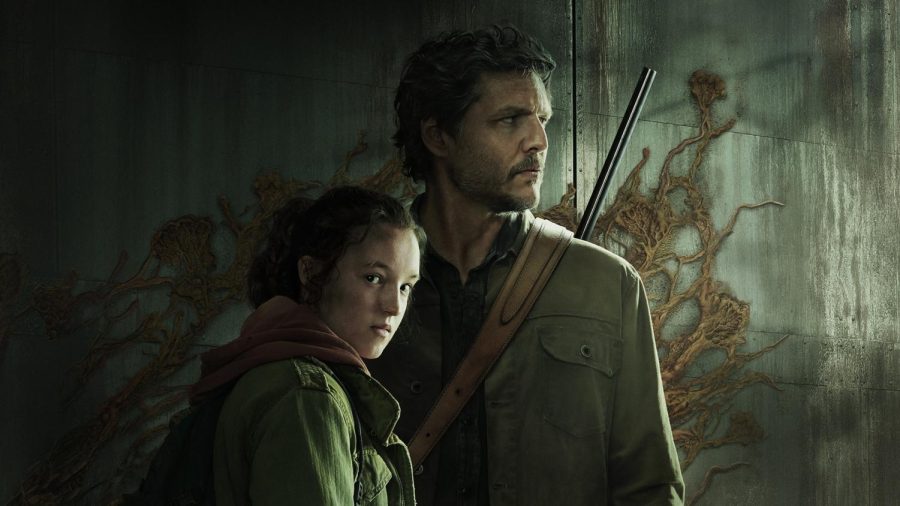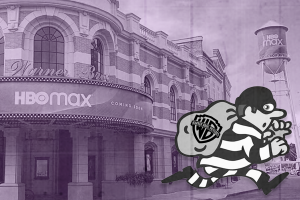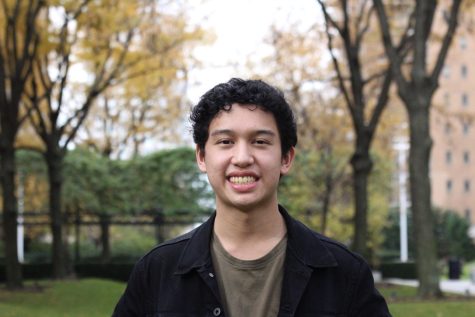‘The Last of Us’ Represents Both the Best and Worst of Us
Two reviewers, one familiar with the video game and one unfamiliar, give their takes on the new HBO show
HBO
At its release in 2013, The Last of Us game received critical acclaim for its story and has since spawned a franchise of five games with one in development.
May 3, 2023
HBO’s most recent hit show, “The Last of Us,” follows a young girl (Bella Ramsey) escorted by a rugged, antisocial man (Pedro Pascal) throughout a desolate America 20 years after a devastating fungi pandemic, based on the real-life fungus cordyceps.
In our world, cordyceps spores enter an insect’s system and take control of its mind and motor skills, forcing it to consume its co-habitants. The parasitic fungus functions similarly with humans in “The Last of Us,” but the protagonist, Ellie, may be the cure to the ongoing devastation.
“The Last of Us” inspired strong thoughts from both fans familiar and unfamiliar with the original video game franchise. Christian is our veteran reviewer, and Vanessa is our newcomer. They provide insight into their experiences watching the show and share their thoughts in these reviews.
Christian’s Review:
After hearing that “The Last of Us” was being adapted into a TV show for HBO, I was excited to see how it would be portrayed since I played the video game in 2019. Once the show finally came out and I finished the season, I was astonished by the show’s adaptation of the beloved video game series.
While the game relied heavily on exploration to develop the narrative, I believe that the show did a spectacular job in worldbuilding and deeply explores how humans should fear themselves. The show usually consists of hour-long episodes, allowing for each episode to vividly depict the post-apocalyptic setting and each character’s experiences in this bleak world.
In particular, the episode that I enjoyed the most was “Long, Long Time,” which focused on Bill (Nick Offerman) and Frank (Murray Bartlett). The relationship between the characters showed that even during a time of crisis, there will always be light if people make an effort to make it happen. For instance, Bill and Frank were able to live peacefully in a town that was untouched by the ravages of the apocalypse.
I also loved how the show gave more development to all characters from the game, such as Sam (Lamar Johnson) and Henry (Keivonn Montreal Woodard), who are two brothers trying to escape a mob in Kansas City. The slight changes in the adaptation to fit the show’s narrative were added to the immersion of the series. Just like the game, the story was easy to follow, and emotional allowing the viewer to deeply connect with the characters and their struggles.
There were noteworthy references to the game, as it shows that the showrunners, Neil Druckmann and Craig Mazin, cared about the source material. As Druckmann was also one of the original game developers, the show displays how much hard work was put into making it a faithful adaptation. The cameos of the voice actors for Joel and Ellie, Troy Baker and Ashley Johnson, were also exciting and emphasized the support for the live-action adaptation.
The first season of “The Last of Us” was a stellar adaptation of the video game. As the series gains popularity — the season finale garnered 8.2 million viewers — it is satisfying that the series is finally getting the attention it deserves. Since the sequel for the video game was released in 2020, it will be exciting to see how the showrunners adapt that storyline for future seasons of the show.
Vanessa’s Review:
I had heard about “The Last of Us” prior to watching the show, but I am not a gamer nor do I have the self-restraint to be one.
I was skeptical before I pressed play, but I was immediately captivated by the bone-chilling cold open featuring an epidemiologist named Dr. Neuman (John Hannah). His character serves as an ideal entry point for a newcomer like me. He downplays the severity of a viral pandemic’s death toll, which is familiar to the audience’s recent experience with COVID-19, in order to juxtapose the catastrophic nature of parasitic fungi like cordyceps.
The first episode, “When You’re Lost in the Darkness,” may be my favorite of the series. The cold open instills a tension into the audience that is shared with Joel’s daughter, Sarah. She is hyper-aware of those around her that may or may not be exhibiting symptoms of a cordyceps infection. When the chaos begins to unfold, the camera work inserts the viewer into Sarah’s position in the car by using long shots and low angles that are reminiscent of Alfonso Cuarón’s film “Children of Men” and the flashback sequence in John Krasinski’s “A Quiet Place Part II.”
Fans of the game were quick to notice how many iconic sequences in the game, including the opening sequence, were duplicated identically. The color grading, camera movement, framing and dialogue are replicated so well that many fans made videos showing visual parallels between the show and video game.
Druckmann and Mazin’s “The Last of Us” made an effort to differentiate itself from all other post-apocalyptic media that we know today — and it succeeded.
The creators, Druckmann and Mazin, were intentional with every detail that occurred on the screen. They made it clear that fidelity was not the priority — immersion was.
The detail and care tended to the sets are just as apparent in the writing. Druckmann and Mazin allow the characters to experience serendipitous moments in which they encounter mirrors of their past selves.
The dynamic between Joel and Ellie is often challenged or enhanced by the presence of other character pairings like Bill and Frank or Sam and Henry. At the end of episode three, Ellie reads aloud a letter in which Bill assigns himself and Joel as “protectors.” Although not explicitly stated, Henry serves a similar role for his younger brother, Sam, in episodes four and five.
“The Last of Us” humanizes its antagonists and encourages its audience to consider their motives. They often share similar philosophies about love and vengeance with the protagonists. The parallels between characters or events are poetic and come naturally rather than feeling empty and forced.
The detail and care tended to the sets are just as apparent in the writing.
The depiction of trauma in the show was honest and given the time, detail and care it required. Joel’s panic attacks in episode six as well as his ability to dissociate while committing acts of violence were not portrayed to make a spectacle of his brutality. These moments showed that he related to Ellie’s desire and desperation to no longer lose anyone else. However, we learn through Joel that our most desperate attempts to be a “protector” may end up hurting those we love. Audiences are left to decide the morality of Joel’s major decision in the finale and reflect on what they would do for love.
Druckmann and Mazin intended for the show’s trolley problem ending to be divisive, but Druckmann has said that many parents align with Joel’s decision. My mother noted that the show is the last thing she thinks of before falling asleep and the first thing she thinks of when she wakes up. Mazin explained in the companion podcast, “As flawed human beings, this is one of the prices we pay for loving people. Loving people tends to trump simple morality, and that’s where Joel finds himself with Ellie.”
Druckmann and Mazin’s “The Last of Us” made an effort to differentiate itself from all other post-apocalyptic media that we know today — and it succeeded. Most post-apocalyptic media attempt to argue that zombies are not the real threat, humans are. However, they often stop there. Druckmann and Mazin push the common trope of humans being the true antagonists further.
I did not expect to become so enamored by the world of “The Last of Us.” The show prioritizes showing the value of love and the joy that nature can bring; however, it also reminds its audience that beauty and destruction can coexist. The novelty of “The Last of Us” is well deserved, and my view of strawberries, giraffes and contractors will forever be changed.
Love for ‘The Last of Us’ Is Infectious at Fordham
Many in the Fordham community shared in the excitement for “The Last of Us,” some even noting that their majors enhanced their enjoyment of the show.
Rebecca Hurson, Fordham College at Rose Hill ’23 and a sociology and theology double major, took a particular interest in the way the survivors interact with one another as well as their differing executions of preserving love. Hurson said, “Like most dystopian stories, I find the interactions the characters have with other survivors to be the most interesting part of the story. Shows like these seem to push the ideas of how humans will behave and what they believe in when faced with ‘the end of the world,’ and it’s hard not to be intrigued.”
Katie Hohman, Fordham College at Lincoln Center ’25, said, “I think ‘The Last of Us’ tackles political mobilization in the face of crisis in a very interesting way, which I really appreciated as a political science major. I enjoyed how each new group Joel and Ellie came across seemed to form ways of living that not only differed from each other but mirrored real, if exaggerated, political camps that exist today.”
The Last of Us’ depth in storytelling not only established one of the biggest shows of the decade, but it allowed for students from various disciplines across Fordham to apply what they have learned and unravel the layers of the show.
















